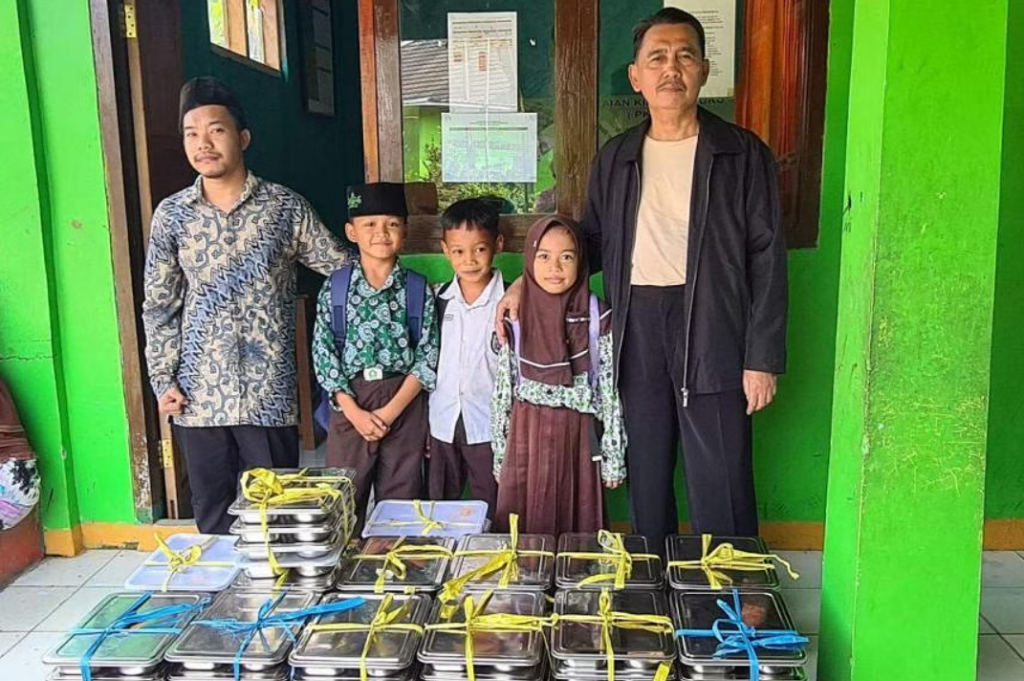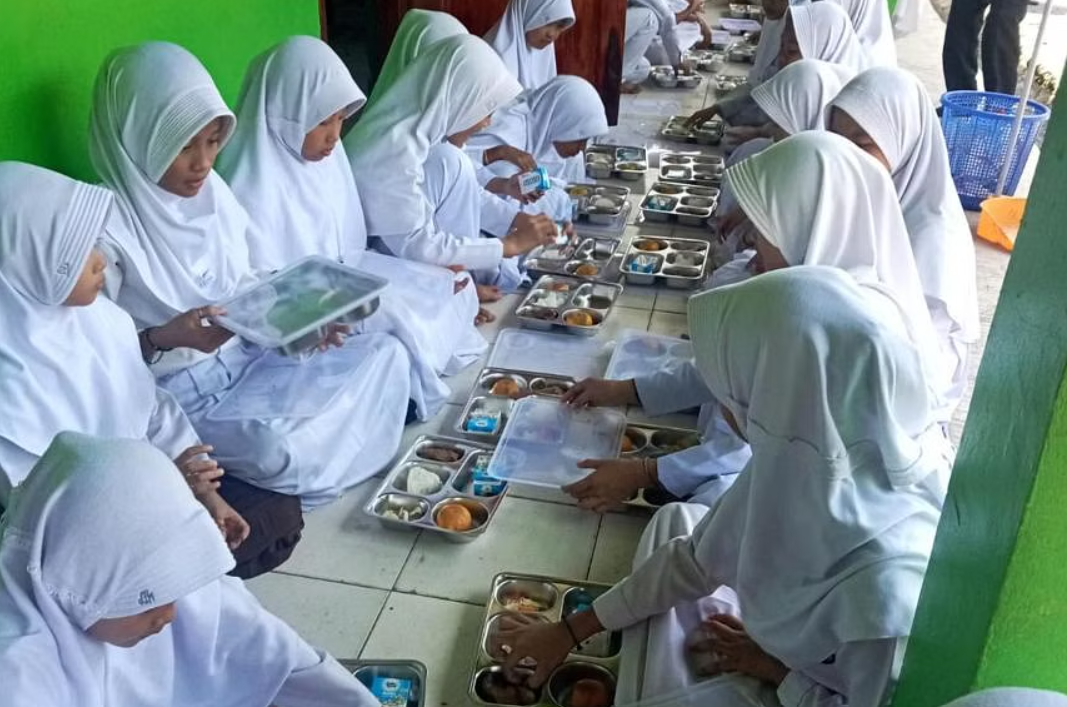A trial programme providing a free meal a day has yielded not just financial relief for households but also improved child nutrition and student outcomes such as attendance and focus.
The free school lunch initiative for children from poor or disadvantaged families was introduced by president-elect Prabowo Subianto and vice president-elect Gibran Rakabuming Raka as one of their key campaign promises. Mr Gibran is President Joko Widodo’s elder son.
But as the programme is being rolled out, it faces criticism over its cost and sustainability.
The pair – who won the Feb 14 presidential election by a landslide and will be inaugurated in October – had in the lead-up to the polls pledged to offer free lunches and milk for students as well as nutritional aid to toddlers and pregnant women in a bid to lower the country’s stunting rate.
Over 20 per cent of Indonesian children under the age of five experienced stunted growth in 2022, according to the UN. Stunting, which is being too short for one’s age as a result of poor nutrition, can result in long-term development delays.
When fully implemented by 2029, the programme will cover 83.9 million beneficiaries across the world’s fourth most populous nation of nearly 280 million, and cost over 400 trillion rupiah (S$33.7 billion) a year – about 2 per cent of annual gross domestic product.
But on the ground, a trial that was first rolled out in January at 16 schools in Sukabumi, in West Java, has been warmly received by around 3,500 students, their parents and school leaders, who have seen positive changes.
For one thing, saving on the cost of lunches for four of her nine children has provided significant financial relief for Indonesian housewife Rofiati, 46.
Her husband, a teacher at an Islamic boarding school in Sukabumi, earns 2.5 million rupiah a month on average, and the free school meals have helped them save about 420,000 rupiah monthly, which she can put towards other household needs.
Her children do not usually have breakfast before school. Before the free lunch programme, her children would eat lunch only upon returning home from school. Lunch would usually consist of instant noodles, or dishes of vegetables, eggs, tempeh or salted fish.
“I am not worried any more because I know they will eat at school. They have more appetite as they eat together with their friends,” Ms Rofiati told The Straits Times, adding that her children’s appetites have improved and they also like the variety of the meals provided. In fact, her 11-year-old daughter has gained 4kg since the programme started.
Every day, students on the programme receive a lunch package worth 15,000 rupiah, containing rice, meat such as chicken, fish or beef, vegetables, fruit and milk.
At home, the family usually eat meat only once a week.
It’s not just the financial savings that parents are happy with. Ms Depi Ratna Juwarti, who has two out of three children benefiting from the free lunches, has noticed other encouraging results.
“They rarely get sick now. They are more motivated to study and spend a longer time studying at night,” Ms Depi said.
Her eldest daughter Adifa Alifiya Mahrain, 12, also has good reviews. “The food is always delicious and the menu changes every day. I always eat everything. It’s a lot of fun to eat together with my friends,” said Adifa, who hopes to become a paediatrician in the future.
Mr Shalahudin Sanusi, the principal of Gelarsari Islamic primary school in Sukabumi, which is trialling the programme, said he has noticed that students have been able to concentrate better and understand the lessons more.
He said the initiative has raised the attendance rate of its 110 students from 85 per cent to 95 per cent. “They eat modestly at home – mostly rice and salted fish. Rice and eggs are the best they can get,” he told ST. “Now, they are so excited, some even arrive in school at 6am, an hour before lessons start.”

The free lunch trial has been extended to other parts of the country, such as Tangerang in Banten.
While educators and parents that ST spoke to lauded the free lunch initiative, it has been criticised by the World Bank, international rating agencies and economists. They fear that its hefty price tag would raise the country’s budget deficit – now capped at 3 per cent of its GDP – and have a negative impact on the economy.
The free meal programme, along with Mr Prabowo’s other policy plans, point to a more expansionary fiscal stance that, if implemented, “would mark a divergence from Indonesia’s long track record of conservatively managing budgetary finances and debt ratios”, Ms Anushka Shah, senior credit officer at Moody’s Investors Service, was quoted as saying by Reuters in February.
However, Mr Prabowo is confident Indonesia will be able to maintain fiscal prudence while also implementing various initiatives, including the free food programme.
“We have studied this. We are very confident we can do that,” he said at the Qatar Economic Forum on May 16.
“We calculate that it’s a matter of refocusing and cutting down the waste, cutting down the allocation to the non-essential activities. So it’s a matter of efficient, good governance, good administration, good management.”
A researcher at Jakarta-based think-tank Core Indonesia, Mr Yusuf Rendy Manilet, said the incoming government will likely reallocate some expenditure from other existing programmes to cope with the budget constraint. But he raised concerns over the consequences of a budget shift.
“In the short term, the budget reallocation will put a few things at stake. An existing programme may not run optimally as its budget is taken or cut, or a new programme cannot be executed as the fund is earmarked for the free lunch programme,” he told ST.
But economist Dradjad Wibowo, a member of the expert council of the Prabowo-Gibran campaign team, told ST the lunch initiative will not disrupt Indonesia’s fiscal stability as it will be adjusted to fall within the available budget.
The programme will also be rolled out in phases, beginning in the least developed regions first, he noted.
In April, a team went to India, which has implemented the Mid-day Meal Scheme covering over 100 million schoolchildren since 1995, to do a comparative study, especially on the cost of meals served, said Dr Dradjad.
India’s Mid-day Meal Scheme began in 1995 and has covered around 118 million children in 1.12 million public schools. Each meal costs 11 US cents (15 Singapore cents) per child, according to Indian Ambassador to Indonesia Sandeep Chakravorty. The scheme has been praised for eliminating hunger and reducing malnutrition, as well as keeping girls and underprivileged children in school.
Despite controversies over the programme in Indonesia, principal Shalahudin is grateful for the free lunches at his school, calling them a “gift from God”. A majority of his students come from poor families whose parents, mostly farm labourers, earn less than one million rupiah a month.
“We hope we will continue to have the meals at our school. It’s been a great help,” he added.



